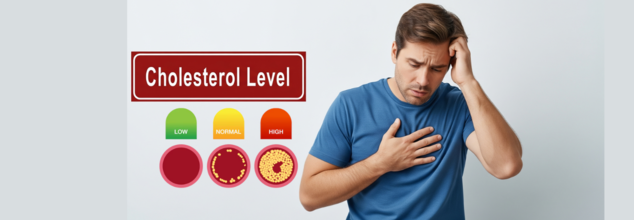- Health Conditions A-Z
- Health & Wellness
- Nutrition
- Fitness
- Health News
- Ayurveda
- Videos
- Medicine A-Z
- Parenting
- Web Stories
Your Cholesterol Levels Could Predict Alzheimer’s Risk And Why the Wrong Meds Could Make It Worse

Researchers might have discovered a unexpected ally in the battle against Alzheimer's disease—spearheading cholesterol-reducing medications. Recent studies indicate that medications such as statins, which have been prescribed over many years to forestall heart attacks and strokes, might also confer significant protection against mental decline.
A paper in the Journal of Neurology, Neurosurgery and Psychiatry has found that those with low levels of "bad" cholesterol (LDL-C) not only have fewer cardiac risks but also have a significantly lower risk of dementia, including Alzheimer's disease. The presence of statins in those with low LDL-C levels further increased this benefit.
These results, coupled with corroborating evidence from U.S.-based scientists, pave the way to rethink how we keep cardiovascular health in line—now with consideration of the brain.
How Cholesterol Affects Brain Health?
Statins are among the most prescribed medications worldwide, with 7–8 million individuals in the UK alone taking them to avoid cardiovascular events. The drugs act by lowering low-density lipoprotein (LDL) cholesterol, the so-called "bad cholesterol," which can block arteries and lead to heart attacks and strokes.
A more in-depth look at population-level health information from South Korea, on over 570,000 people, added a fascinating new twist: the lowest LDL-C group—below 1.8 mmol/L—were 26% less likely to have dementia and 28% less likely to have Alzheimer's than the group with LDL-C of more than 3.4 mmol/L.
Additionally, statin users with low levels of LDL-C had a further 13% lower risk of dementia and 12% lower risk of Alzheimer's than non-users.
"These results highlight the significance of LDL-C management not only in preventing heart disease but as a key component of an anticipatory approach to neurodegenerative disease prevention," researchers stated in their study. "Targeted statin prescriptions that aim at optimal levels of LDL-C could maximize cardiovascular as well as cognitive benefit."
Relationship Between Brain Function and Blood Lipids
Yet another study, this one from the Glenn Biggs Institute for Alzheimer's and Neurodegenerative Diseases at UT Health San Antonio, supports the notion that the relationship between brain and cholesterol is real—but not necessarily simple.
Dr. Sokratis Charisis, a neurologist and senior researcher, examined data from the landmark Framingham Heart Study and reaffirmed that high levels of LDL are causally linked with cardiovascular disease and dementia.
Though, the information pulled a surprise in regard to HDL—often called "good cholesterol." Long hailed for its cardio-protective qualities, low levels of HDL were found to be associated with a decreased risk of Alzheimer's disease, indicating a more nuanced biological interaction between cholesterol subtypes and cognitive impairment.
"It speaks to the fact that this relationship may not be as straightforward as we believe," said Dr. Charisis. "There may be completely different mechanisms linking blood lipids to brain health as opposed to cardiovascular health."
What Really Affects Alzheimer's Risk?
Charisis also pointed out a third lipid marker—ApoB48, a lipoprotein that carries dietary fats in the blood. Though not usually tested as part of regular cholesterol checks, higher levels of ApoB48 were associated with a reduced risk of Alzheimer's, suggesting unforeseen levels of biological interplay between the diet, lipid metabolism, and brain deterioration.
"This finding is especially noteworthy," said Charisis, "because it potentially could be used to help identify a new biomarker that can ultimately inform predictive diagnostics and personalized treatment strategies."
The significance of this developing research is immense. As of 2019, an estimated 57.4 million individuals globally were affected by dementia, a figure that is predicted to increase more than twice over—that is, 152 million by the year 2050, according to international health organizations.
As Alzheimer's disease is responsible for most cases of dementia and there is no cure yet, prevention and early treatment are more essential than ever. Changes in lifestyle, reduction of cardiovascular risk, and now control of lipids could be the cornerstones of a multi-faceted approach to neurodegeneration.
While statins have traditionally been seen from the perspective of heart health, this new evidence indicates they might also be repurposed or more targeted in their prescribing for brain health, particularly among aging adults.
Yet the results also highlight the importance of individualization. What is good for one brain may not be equally useful for another, especially when age and cholesterol levels are considered. "Perhaps it will be crucial to have dynamic cholesterol targets depending on the patient's age, health status, and genetic profile," Charisis said.
This opens up the possibility of more individualized treatment regimens—not only prescribing statins by cardiac risk, but also including cognitive health evaluations in the decision-making process.
For the time being, specialists continue to recommend regular monitoring of cholesterol levels and early treatment of cardiovascular risk factors. Although you shouldn't start statin therapy just to minimize dementia risk without a doctor's advice, having a healthy LDL-C value is a definite boon to both heart and brain.
Individuals worried about cognitive impairment—particularly those with a family history of Alzheimer's—are advised to:
- Monitor their lipid profiles on a regular basis
- Consult with a healthcare provider regarding cholesterol-lowering therapies
Adopt habits of lifestyle that foster both cardiovascular and cognitive health: exercise, a Mediterranean diet, managing stress, and sleep
32-Year-Old Woman Ends Up In The Hospital After Popping A 'Triangle Of Death' Pimple

(Credit - Canva)
We have all popped our pimples even though we know how it could hurt us. Popping pimples could lead to marks and small infections, however for the satisfaction of being rid of it, many people do it. While they think the consequences of the same may not be as bad, this case may change your view.
Alisha Monaco, a 32-year-old woman was rushed to the hospital after she popped a pimple at the ‘triangle of death’ on her face. In a recent viral video shared on TikTok, Alisha explained how this pimple was just like many she has had each month. When she failed to squeeze it, she popped it with a sterilized spot-popping needle. However, unlike any other pimple, which would’ve popped and hurt for a moment, she detailed how her ears popped, followed by immediately feeling dizzy.
The 32-year-old explained how the pain was on the right side of her nostril and had spread towards her lip as well as that side of her face.
Even after hours of rest, she woke up with excruciating pain on the right side of her face and the whole right side of her face was swollen.
At the hospital, the healthcare professionals treated the situation promptly due to the high risk of infection in that area, and she was also prescribed medication to ensure no infection spreads. She later took to social media to warn people about the triangle of death.
What is The Triangle of Death?
According to 2023 article in the Journal of Morphological Sciences, the area that spans from the top of your nose to the sides of your face is known as the dangerous triangle of the face or triangle of death. This area is where our cavernous sinus (CS) is situated. The CS is a space in your brain behind your eyes that holds important nerves and blood vessels. Think of it as a busy intersection for nerves that control eye movement, and for a major artery that brings blood to your brain.
What Happens When The Triangle Of Death Gets Infected?
An infection in this area can be very serious. It can damage the nerves there, leading to problems with your eyes, like trouble moving them or feeling pain in your face. The infection can also easily spread to other parts of your head and body, causing:
Meningitis: A dangerous infection of the protective layers around your brain.
Abscesses: Pockets of pus in the brain or other organs.
Hormone problems: Since the sinus is close to a gland that controls your hormones, an infection can mess with your body's hormone levels.
What Should You Do Instead Of Popping The Pimple?
The Cleveland Clinic explains that It can be tough to resist the urge to pop a pimple, but there are safer ways to handle a breakout, especially in this risky area. Try these tips to help it heal faster without the danger:
Use a warm compress
Soak a washcloth in hot (not scalding) water and hold it on the pimple for 10-15 minutes. This can help draw the pus to the surface and speed up the healing.
Try a pimple patch
If the pimple has already opened, a patch can help absorb the fluid and protect the area overnight.
See a dermatologist
If you have a big event or need a quick solution, a doctor can safely treat the pimple with things like cortisone or antibiotic injections.
Jana Duggar Is Pregnant: Why the First Few Weeks of Pregnancy Matter More Than You Think

Credits: Canva, janamduggar/Instagram
Counting On star Jana Duggar, 35, and her husband, Stephen Wissmann, are expecting their first baby. The couple, who tied the knot last year, shared their happy news on Instagram with a glowing caption. Fans went wild, but beyond the sweet announcement, there is something worth talking about: the earliest weeks of pregnancy, when so much of the story of new life quietly unfolds.
Pregnancy is often spoken about in trimesters, but the very beginning, the hush-hush early weeks, is where the groundwork is laid for everything to come. And whether you are a reality TV star or not, those first days carry immense importance.
Many women do not even realise they are pregnant in the earliest days, but the body is already in full construction mode. Hormones like hCG (the one that makes pregnancy tests turn positive) and progesterone start working overtime to prepare the uterine lining, support the embryo, and guard against early complications.
Why “Early Care” Is Everything
Doctors always stress that if you are planning a pregnancy or even just considering it, those first few weeks are the ones you need to prepare for the most. Folate, for instance, is a superhero nutrient in these early days. Adequate folic acid before and during early pregnancy can prevent neural tube defects, serious conditions that form in the embryo’s first month.
Skipping prenatal vitamins during this window is like forgetting to pack your parachute before a skydive. Most of the development of the brain and spinal cord happens before you even hit 12 weeks.
The Unseen Risks of Everyday Life
The early days are also when lifestyle habits make the biggest difference. Alcohol, smoking, and even certain over-the-counter medications can have a bigger impact during this time than later on. That is why many doctors advise women of childbearing age to adopt healthy routines before conception itself.
It is not just the headline habits either. Too much caffeine, poorly cooked meats, or even that unwashed salad can carry risks in early pregnancy when the immune system is slightly suppressed. It might sound fussy, but those small adjustments help lay a safe foundation for the months ahead.
Why Rest and Stress Matter A Lot
Everyone loves telling expectant mothers to “rest”, but in those early days, rest is not just about catching up on Netflix. It is about helping the body handle the metabolic overload of creating a new human. Fatigue is often one of the first pregnancy symptoms, and it is not just in your head; the body is literally doubling its workload.
Stress, too, plays a silent role. High cortisol levels can affect implantation and early growth. While it is impossible to live stress-free, the early days are when building calming routines, whether through gentle exercise, journaling, or mindfulness, can pay off in the long run.
The Emotional Rollercoaster Nobody Warns You About
The funny thing about early pregnancy is how invisible it feels. Outwardly, nothing looks different, but inside, everything is changing. That mismatch can be confusing. Some days it is all excitement, baby names, nursery ideas, and Instagram reveals. Other days it is nerves; what if something goes wrong?
That duality is completely normal. Roughly 1 in 4 pregnancies end in miscarriage, most often during those early weeks, and while the statistic can be scary, it is also why early prenatal care and open conversations are so important. A good support system can help balance joy with realism.
Why Jana’s News Hits Different
At 35, 19 Kids and Counting star falls into what doctors call “advanced maternal age”, which simply means pregnancies need a little more monitoring. But it is also proof that every journey is unique. The fact that she and Stephen are openly celebrating the news shows how much hope and excitement early pregnancy carries, even in its uncertainty.
For her, January 2026 will bring a baby. For the rest of us, it is a reminder that the earliest weeks of pregnancy, while quiet and often unseen, are some of the most powerful days in the making of a new life.
While the first weeks of pregnancy may not come with a visible bump or cute baby kicks, they are the foundation of the entire nine-month journey.
From 'Frankenstein Rabbits' To 'Zombie Squirrels': What These Unsettling Traits Reveal About Parasitic Illnesses

Credits: AP/Evelyn's Wildlife Refuge/X
Every summer, social media fills with unsettling images of backyard wildlife that look more like extras from a low-budget horror movie than neighborhood critters. This year, it’s squirrels with grotesque sores and rabbits sprouting what appear to be black, tentacle-like horns from their heads. While the sight is shocking, scientists say these conditions are less terrifying than they appear—and in many ways, they’re teaching us important lessons about viruses, immunity, and even human health.
In northern Colorado, residents recently spotted wild rabbits with twisted, horn-like growths protruding from their faces. Reports came in from Fort Collins, where some of these animals looked like they had sprouted black tentacles instead of fur.
What Are Frankenstein Rabbits?
Colorado Parks and Wildlife (CPW) quickly confirmed the culprit- Shope papillomavirus, a virus first identified in the 1930s. The infection causes keratin-based growths made of the same material as human nails and hair—that can grow into elongated, horn-like shapes.

For most rabbits, the infection is temporary. “They’re able to clear it from their system on their own,” says Kara Van Hoose, CPW spokesperson. Once the immune system suppresses the virus, the horns dry out and eventually fall off. But in some cases, the growths can interfere with eating, foraging, or even vision. Rarely, they can develop into squamous cell cancers.
Importantly, Shope papillomavirus only infects rabbits and hares—not humans or pets. The growths themselves aren’t contagious. Instead, the virus spreads via bites from mosquitoes, fleas, and ticks, which is why sightings spike in summer and then fade with the first frosts.
A Virus with A Surprising Legacy
The rabbit virus may look like a strange wildlife quirk, but its scientific significance is immense. Richard Shope, the virologist who identified it in 1933, later contributed to research on influenza A and traced links to the deadly 1918 flu pandemic.
Even more importantly, his studies of rabbit papillomavirus helped scientists understand human papillomavirus (HPV), a pathogen now known to cause several cancers. This research eventually led to the development of the HPV vaccine, one of the most effective tools in modern cancer prevention.
In other words, the bizarre-looking horned rabbits of Colorado are part of a story that connects animal health, human medicine, and the fight against one of the world’s leading cancer-causing viruses.
What Are Zombie Squirrels?
If the horned rabbits weren’t alarming enough, homeowners across the U.S. and Canada have reported squirrels with grotesque, oozing sores. Dubbed “zombie squirrels” on Reddit and local news outlets, these animals often appear bald, scabby, and covered in tumors.

At first, some feared this was squirrelpox, a rare and often deadly virus primarily found in red squirrels in the U.K. But experts now say that in North America, most cases are actually squirrel fibromatosis, caused by a virus called leporipoxvirus.
Like the rabbit papillomavirus, fibromatosis creates wart-like growths that may burst and ooze fluid. The disease looks disturbing, but it usually clears up on its own within four to eight weeks. Gray squirrels, which are common across the U.S., generally recover fully.
How the Virus Spreads Among Animals?
Unlike the horned rabbit virus, which is spread by biting insects, squirrel fibromatosis spreads through direct contact with infected saliva or lesions. That means the backyard bird feeder—a favorite stop for squirrels—can act as a transmission hub. Infected squirrels may leave saliva on seeds, which is then picked up by others.

“Shevenell Webb, a wildlife biologist in Maine, explains it like this: ‘It’s like when you get a large concentration of people. If someone is sick and it spreads easily, others are going to catch it.’”
Although it’s upsetting to see squirrels in such poor condition, the disease does not spread to humans, dogs, or cats. Experts strongly advise against touching or attempting to “rescue” infected squirrels.
Should We Worry About Human Risk?
Here’s the key point: Neither rabbit papillomavirus nor squirrel fibromatosis poses a risk to people. These viruses are species-specific, meaning they evolved to target only their animal hosts.
That said, wildlife experts caution against close contact. Wild animals can carry other pathogens, and distressed animals can bite or scratch. The safest approach, they say, is observation from a distance.
At first glance, these conditions look like nothing more than cruel tricks of nature. But the history of virology shows that studying animal viruses has repeatedly advanced human medicine. The rabbit papillomavirus directly contributed to the eventual creation of the HPV vaccine. Even squirrel fibromatosis, though less studied, provides clues about viral behavior, transmission dynamics, and immune response.

There’s also a conservation angle. Tracking these conditions helps wildlife officials monitor population health and understand how environmental changes, including warmer summers and denser urban habitats, may amplify disease spread.
It’s worth noting that both the horned rabbits and zombie squirrels came into the public spotlight through viral photos online. Platforms like Reddit and X (formerly Twitter) have become informal early-warning systems for unusual animal illnesses. While this sometimes fuels fear, it also provides wildlife agencies with useful crowd-sourced data.
As Van Hoose points out, it’s difficult for agencies to know whether multiple sightings represent several infected animals or just the same one seen repeatedly. Public reports when paired with expert analysis help build a clearer picture.
What to Do If You Spot A ‘Frankenstein Rabbits’ or ‘Zombie Squirrels’?
If you see a rabbit with horns or a squirrel with sores, the advice is straightforward:
- Do not touch or feed the animal.
- Do not attempt to trap or euthanize it.
- Report sightings to local wildlife authorities if requested in your area.
These animals, though unsightly, are usually not suffering long-term. Many recover naturally once their immune system clears the virus.
From rabbits with keratin “horns” to squirrels with wart-like sores, these strange cases highlight how deeply intertwined wildlife health is with human understanding of disease. They remind us that viruses are not just human problems—they shape ecosystems, influence evolution, and sometimes, unexpectedly, lead to breakthroughs that save lives.
© 2024 Bennett, Coleman & Company Limited

